Education: Overview
Emotions play a critical role in learning and test performance. Many individuals utilize the emWave® system to help manage their anxiety and improve academic focus and memory recall. Because the emWave system provides students of all ages with real time feedback on their internal experience, it becomes an engaging and compelling way to self-regulate their emotions.
Educators and parents also use this technology to help their students or children address behavior management issues. At schools, universities, clinics, and homes, students are learning to harness the power of positive emotions through the emWave experience to:
- increase their academic focus
- make better decisions
- reduce impulsivity
- manage anger
- get along better with their peers
As individuals practice the Quick Coherence® technique with the emWave systems, they are able to see and experience the changes in their heart rhythm patterns. The patterns become smoother and more wave-like as a person feels appreciation and other positive attitudes and emotions. This process reinforces an association in the brain between heart coherence (when the physiology is in sync) and positive feelings.
Who can benefit from the emWave system:
- Students needing greater management of stress, anxiety, and anger
- Students experiencing performance anxiety in test taking, sports, and public presentations
- Administrators who are fatigued or stressed
- Teachers who are fatigued or stressed
- Teachers teaching key concepts in health, physiology and biology classes
Different Learning and Testing Environments that Use the emWave system:
- Regular classrooms
- Special Education classrooms
- Adult Education classrooms
- After school programs
- Learning and Tutoring Centers
- SAT test prep courses
- Counseling offices
- Therapeutic offices
- Clinics that treat ADD/ADHD/ED/Autism/Panic Disorders
- Computer labs
- Research projects
- Administrative offices
- University lecture halls
- Advisory programs
- Sports Training Camps
- Juvenile Correction Facilities
emWave Pro Labs and Site Licenses
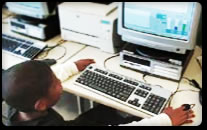
emWave® Technology labs and site licenses are available for use in educational organizations anywhere in the world. They provide a cost effective method of giving large numbers of students the opportunity to more effectively build emotional resilience and focus, leading to improved attitudes, behaviors and academic performance.
How to Use the emWave system in the Classroom
- Introduce the emWave system by doing a classroom demonstration. Explain what the emWave system is, how people benefit, and then ask for a volunteer to demonstrate the technology.
- Practice the Quick Coherence technique. Before having the rest of the class use the emWave system, guide the class through the Quick Coherence technique several times. Practicing this technique helps students perform better on the emWave system.
- Have students identify a goal. State that the goal of the emWave system is to transfer the skills students learn with this technology to real-life situations where there is stress and conflict, or a need to perform better in some area of life.
- Begin Use of the emWave system. Instruct the entire class to first use the Heart Rhythm Display section. Their initial sessions should be short (two to three minutes at the most). Have them record their results on a scoring sheet or on the computer.
- Move onto the Software Games. When students have improved to where the coherence score is 50% or less in the red bar (low coherence), then they are ready to begin playing the software games.
- Check regularly with students on their progress. Frequently monitor students’ use of the emWave system, checking on their individual scores and how they are applying what they learn at school, home, or in relationships. Students should use the emWave system a minimum of 6 to 10 times to best internalize the skill sets learned from this technology.
How to Use the emWave system with Individuals
- Introduce the emWave system. Explain what the emWave system is, how people benefit, and then ask the individual being counseled to try the technology.
- Practice the Quick Coherence technique. Guide the individual through The Quick Coherence technique several times. Practicing this technique will help those being counseled to perform better on the emWave system.
- Have the individual identify a goal. State that the goal of the emWave system is to transfer the skills an individual learns with this technology to real-life situations where there is stress and conflict, or a need to perform better in some area of life.
- Begin Use of the emWave. Instruct the individual to first use the Heart Rhythm Display section. His or her initial session should be short (two minutes at the most). Have the individual record the results on a scoring sheet or on the computer.
- Move onto the Software Games. When an individual has improved to where the coherence score is 50% or less in the red bar (low coherence), that person is ready to begin playing the software games.
- Check regularly on his or her progress. Frequently monitor how the individual is doing with the emWave system, checking on scores and applications at school, home, and in relationships. Individuals should use the emWave system a minimum of 6 to 10 times to best internalize the skill sets learned from this technology.
Tips and Traps:
- Students perform better on the emWave system if they are given time beforehand to practice the steps of the Quick Coherence technique. This includes practicing rhythmic heart breathing and clearly identifying an image (a person, place, or strong memory) that evokes a positive emotion.
- Request that students avoid excessive movement, otherwise the emWave system will show red lines or artifacts on the computer screen that indicate no pulse connection.
- Some students will need extra reinforcement to breathe rhythmically and choose an image that evokes a positive emotion in order to move out of the low or red coherence level.
- Begin using the emWave system in short time frames to maintain interest and challenge.
- Discourage score comparisons among classmates. Tell students that scores will vary sometimes depending on different factors, including individual moods, ear or hand temperature, diet, or what events preceded their current session. Generally speaking, if students show sustained focus, they will make progress.
- Don’t let students use the emWave system for long periods of time while using the heart rhythm display. Some will get bored or lose interest without a goal, structure, or incentive.
Education: Results
Programs incorporating HeartMath tools and the emWave coherence-building technology have been introduced in hundreds of schools and other learning settings throughout the U.S. at the preschool, elementary, middle school, high school, college and graduate levels to help students learn and perform to their maximum ability. A growing body of research confirms and validates the experience of countless students, parents, teachers and counselors, showing that these tools significantly improve students’ emotional well-being, relationships, classroom behavior, learning and academic performance. Moreover, results show coherence training produces significant benefits in students across the full spectrum of academic levels and abilities. It is also a particularly effective intervention for children with ADHD, learning challenges and special education needs. The results of several research studies conducted with diverse student groups are summarized here. Because extensive research shows critical links among stress resilience, social and emotional competence, learning and academic outcomes, studies examining a range of these factors are included.
“The emWave technology gives me real-time feedback on the power of the HeartMath tools while also documenting my journey to reset my emotional and physiological baseline to a more positive, healthful, and productive rhythm.”
— Jefferey Lagozzino, Principal, La Primaria Elementary School, El Monte, California
Click here to read full research papers and articles related to the impact of the HeartMath tools and technologies on learning and testing.
Increasing Stress Resiliency and Social-Emotional Competence in Middle School Students
The Miami Heart Research Institute conducted a study to examine the impact of a HeartMath program on middle school students at a Florida school. School counselors had observed that many of the students were distracted at school by various social pressures and negative emotions such as anxiety and depression, which diverted their attention from learning. Many students exhibited lack of motivation and risky behavior, and some were considered to be at risk of becoming dropouts. The emWave system was used in this school as part of several classroom based programs to facilitate learning of the HeartMath tools.
The first phase of this study, involving 32 seventh-grade students, assessed changes in students’ social-emotional competence, including measures of achievement aptitude, mental attitudes and interpersonal skills.
- Results showed that after learning and practicing the HeartMath tools, the students exhibited statistically significant improvements in 17 of the 19 areas assessed. These included a marked reduction in risky behaviors and improvements in stress and anger management, self-reliance, motivation, work management and focus, and relationships with teachers, family and peers (see figure below).
- A follow-up analysis indicated that many of these improvements were sustained over the following six months.
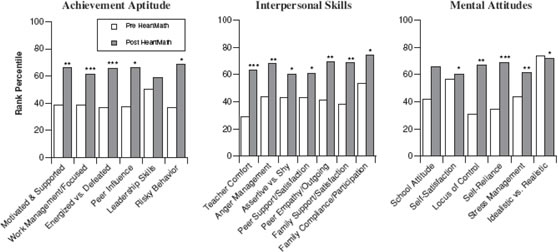
The second phase of this study, involving 60 students in the sixth through eighth grades, examined the impact of the HeartMath tools on children’s physiological responses to stress – an objective measure of their stress resilience. As a measure of cardiovascular and nervous-system dynamics, students’ heart-rate variability was measured immediately prior to, during and after a structured interview designed to elicit emotional responses to real-life stressful issues.
- Results showed that compared to a control group of students who used the Quick Coherence® technique after experiencing acute emotional stress, demonstrated significantly increased heart-rate variability and heart-rhythm coherence.
- These results demonstrated the HeartMath-trained students were able to favorably modulate their physiological stress response in real time, thus demonstrating increased stress resilience compared to the control group.
Improving Test-Taking Skills and Test Performance in High School Students
A study, conducted by clinical psychologist Dr. Pam Aasen and reading curriculum specialist Stephanie (Thurik) Carlson, in association with the Minneapolis Public School District, examined the impact of a HeartMath program on test-taking skills and test performance in high school students. Twenty seniors participated in a three-week intensive program. All of them had previously failed their state-required high school exit exams and needed to retake the tests to graduate. The course included about eight hours of instruction in HeartMath tools, with an emphasis on reducing test-related anxiety and instilling greater emotional stability and self confidence. Students received heart-rhythm coherence feedback training with the emWave system to help them learn how to self-generate coherence, reduce anxiety and increase nervous system harmony.
- After the program, the students showed improvements in test-taking performance that greatly exceeded those achieved through standard academic preparation alone.
- The group demonstrated a mean increase of 35% in math scores and 14% in reading scores on the Minnesota Basic Standards Tests (see figure below) – gains that represented one- to two years’ growth in academic skills.

- The students’ passing rates on the exams also improved substantially. Of the HeartMath trained students retaking the math test, 64% passed, compared to 42% for all seniors in the district retaking the test at that time. The trained group’s passing rate was 55% in reading, compared to 31% for the district.
- Compared to a control group of 20 untrained students, the HeartMath-trained students also demonstrated significant improvements in emotional well-being following the program, as measured by the Brief Symptom Inventory. Improvements included significant reductions in hostility, depression, interpersonal sensitivity – feelings of personal inadequacy inferiority and self-doubt – physical symptoms stemming from stress and global indices of distress (see figure below).
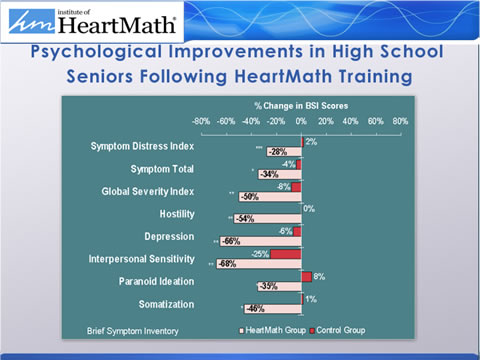
“The students made gains that were significant because they represented one- to two-years’ growth in reading or math with only one month of preparation and instruction. This clearly shows that in teaching students how to use HeartMath tools they were able to reduce their test-taking anxiety and more accurately show us what they know.”
—Stephanie Carlson, Secondary Reading Curriculum Specialist, Minneapolis Public Schools
The TestEdge National Demonstration Study: Reducing Test Anxiety, Increasing Test Scores and Improving Social-Emotional Functioning
“By providing a program that helps students reduce test anxiety, we saw a greater daily attendance than for nonparticipating students. Participating students were more focused and performed more confidently on California State Standards Tests. Our school’s test scores soared, far exceeding the NCLB (No Child Left Behind) targets. In Language Arts our students’ proficiency grew from 26% to 47%, and in Mathematics from 60% to 71%.”
—Jefferey Lagozzino, Principal, La Primaria Elementary School, El Monte, Ca.
In 2004, the U.S. Department of Education funded a multisite study to investigate the efficacy of HeartMath’s TestEdge® program in reducing stress and test anxiety and improving emotional well-being, quality of relationships and academic performance in students. This large-scale investigation included both primary and secondary studies, involving students and teachers in diverse elementary, middle and high schools in eight states.
The primary investigation, designed as a randomized controlled field study, included a total of 980 10th-grade students at two California high schools. One of these schools was randomly selected as the intervention site and the other served as the control. Students at the intervention school participated in the TestEdge program, a classroom-based learning program incorporating tools, concepts and techniques that enable students to better recognize and self-regulate stress, test anxiety and other emotion-based blocks to learning and test performance. The program was taught during the spring semester, before students were to take two statewide standardized tests. Throughout the semester, students practiced applying the HeartMath coherence-building tools and technologies in test preparation and test taking to achieve the following: increase retention and relevance of academic material; increase emotional self-awareness; and more effectively handle stress and challenges, both at school and in their personal lives. Coherence training with the emWave system was incorporated as an integral part of the program and students were given the opportunity to use this technology both in and outside of class.
Extensive quantitative and qualitative data were gathered in both schools using survey questionnaires, interviews, structured observation and student drawings, along with student standardized test scores on the California High School Exit Examination (CAHSEE) and the California Standards Test (CST). In addition, an electrophysiological substudy was conducted with a subsample of students. Utilizing measures of heart-rate variability, this controlled laboratory experiment investigated the degree to which students had learned the techniques taught in the TestEdge program by providing an objective measurement of their ability to shift into coherence prior to taking a stressful test.
Among the key findings of the study were the following:
- Across the whole sample before the TestEdge® intervention, 61% of students reported being affected by test anxiety, with 26% experiencing high levels of test anxiety often or most of the time.
- There is a strong association between test anxiety and academic performance. The greater the level of test anxiety, the lower the test scores. On average, students with high levels of test anxiety scored 15 points lower on standardized tests in both math and English than those with low test anxiety.
- The TestEdge program was highly successful in significantly reducing test anxiety in the students who participated in the program.
- Of the students who initially suffered test anxiety, 75% had reduced test anxiety by the end of the program. This reduction also was evident for more than three-quarters of all classrooms and was observed throughout the academic ability spectrum – from students in the highest-performing classes to those in the lowest-performing classes.
- Students participating in the TestEdge program also demonstrated significant improvements in numerous measures of emotional and social functioning, including:
- Reductions in feelings of loneliness, sadness, anger, depression and disappointment.
- Improvements in their emotional awareness, power to control their feelings and measures of emotional discord – i.e., they were not as overwhelmed by their emotions and did not repress negative feelings.
- Improvements in their awareness of others’ feelings – empathy – ability to share their feelings with others, sense of being understood and ability to avoid arguments or fights.
- Increases in enjoyment of class, engagement, positive feelings towards classmates and perception of teacher care.
- Although the study did not find a significant increase in test scores for the intervention group as a whole, four subgroups of students, ranging in size from 50 to 129, did have significant increases in test performance – an average of 10 to 25 points – following their participation in the TestEdge® program. These improvements in test performance also were associated with improvements in emotional disposition and stress management.
- Results from the physiological study showed:
- Students participating in the TestEdge program had acquired the ability to shift into the coherence state prior to challenging situations such as taking an important test.
- This capacity to shift to coherence was associated with significant reductions in test anxiety and corresponding improvements in measures of emotional disposition. As noted above, it also was associated with improved test performance for a portion of the students.
- Students in the program also showed an overall increase in their “resting” measures, without conscious use of the tools, heart-rate variability and heart-rhythm coherence over the four-month study period. This important finding suggests that through consistent practice of the HeartMath tools, students were effectively able to internalize coherence as a new, familiar reference state. Coherence creates a more healthy, harmonious and adaptive pattern of psychophysiological function directly associated with improved autonomic nervous-system function, emotional stability, stress resilience and cognitive performance. This finding adds to the strong body of evidence indicating that HeartMath coherence-building tools and technologies facilitate a fundamental repatterning process, whereby a more healthy pattern of psychophysiological function is progressively established in the neural architecture as a new baseline or set point.
- In conclusion, consistency across the various quantitative, physiological, and observational findings demonstrates the TestEdge® program led to a number of important successes, impacting multiple dimensions of students’ lives. Results show that over a relatively brief period of time, students were able to substantially reduce test anxiety, improve test performance and make significant positive changes in emotional disposition, stress resilience, attitudes toward school, relational dynamics and psychophysiological function.
“I really found that [the HeartMath tools] helped me a lot with my emotions, my relationships with my friends and family, and just in everyday life, especially when I’m really stressed out.”
—10th-Grade Student and Study Participant, San Benito High School, Hollister, Ca.
For further details on the design, implementation and findings of the TestEdge National Demonstration Study, see the full report at: https://www.heartmath.org/research
Improving Learning and Proficiency in Math
A major concern in our current educational system is the significant number of students entering college who do not meet the basic minimum academic requirements for enrolling in college-level courses. These students must take remediation courses in core academic subjects before they are ready to enter regular college classes. The University of Cincinnati at Clermont (UCCC) and the Greater Cincinnati Tech Prep Consortium have formed a partnership to help remedy this problem, their goal being to reduce the need for remediation. Working with this program, Drs. Michael Vislocky and Ron Leslie, UCCC professors of math and psychology, respectively, have pioneered a new approach.
Vislocky and Leslie have been working intensively with teachers at local high schools to help them effectively integrate HeartMath coherence-building tools and the emWave technology into mathematics instruction. The goal is to improve high school students’ learning, comprehension and retention of math so they are better prepared for college.
“I’m ecstatic! High school students are excited about this program because it gives them an edge in learning math and in demonstrating their proficiency on tests. Many students who felt discouraged about their math performance now feel confident that they can succeed.”
— Dr. Michael Vislocky, Professor of Mathematics, University of Cincinnati at Clermont
The results have been extremely promising. The figure below shows data from one 11th-grade math class as an example of the type of improvements that are being achieved. Students’ scores on the Compass college placement test in algebra are compared prior to being exposed to HeartMath and again seven weeks later, after using the tools and the emWave system as an integrated part of their math instruction.
- Results show a statistically significant average increase of 27% in student scores on the college placement test in algebra after practicing HeartMath in their math class.
- These findings suggest the integration of coherence-building tools and technologies into the instruction of core academic subjects can be an effective way to enhance student learning and academic performance, and to better prepare high school students for higher education.
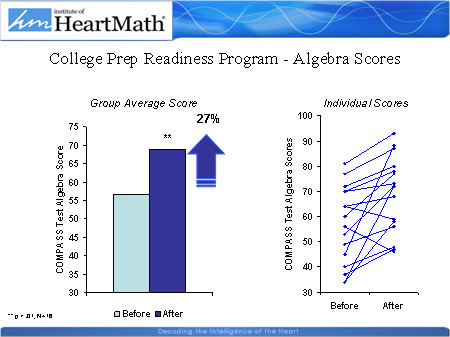
Student participants describe how they apply HeartMath skills in various areas of their lives:
“I use [HeartMath] every day before math class. This helps me understand the concepts and grasp them more easily.”
“HeartMath has obviously helped in my Algebra II class. On the last test, using [HeartMath], I scored a 97%. It really calmed me down and opened my mind to clearer thinking.”
“I was taking a test in chemistry, and I could not remember the equation for the test. I had 3 minutes left and I used one of those minutes to do HeartMath. … I ended up getting a 90% on the test and brought my chem grade up.”
“(One) instance was a presentation in English class. I am a shy, solitary person and I sometimes get very stressed with presentations. However, I used what I learned from HeartMath and was able to present my topic efficiently.”
“Whenever I e-mail or write my boyfriend, who recently left to work in Utah over the summer, I use HeartMath to calm down and say what I want to say without sounding angry, upset and panicked.”
“Working at Coney Island, I’m around people all the time; being an assistant manager, the questions, concerns and complaints all come to me. In order to answer them or handle the situation without taking it personally, I use HeartMath. It’s helped calm my nerves a lot.”
“Sometimes during sport activities I get mad at myself and do very badly. One time I used [HeartMath] and I let all of my stress go and just had fun. In the end, I performed better than I expected.”
“I have used [HeartMath] during band. I hate the feeling of having to play a hard part in front of the whole band by myself. I get so nervous sometimes that my hands shake and my mind goes blank. … I have seen a significant improvement in my playing alone in front of people.”
“I used [HeartMath during] any stressful encounter I had, whether at home, school, with my parents, or with friends. Any time I got frustrated or upset, I tried to [use the HeartMath techniques] and focus from head to heart.”
New Help for Children with ADHD
Many parents, teachers and clinicians have seen remarkable results in using HeartMath tools and the emWave system with young people who have ADHD. Below is an excerpt from an article written by clinical psychologist Dr. Shari St. Martin. Dr. St. Martin runs three clinics in Mexico and also works with the Mexican school system. Through her work using HeartMath and the emWave system, she has succeeded in helping nearly 400 children with ADHD get off all of their medications.
Excerpt from: The Garden of the Heart: HeartMath – The New Biotechnology for Treating Children with ADD/ADHD and Arrhythmia, by Dr. Shari St. Martin, Ph.D., ATR
Since 2001, in Guadalajara, I have used the HeartMath technology in the successful treatment of 396 children with ADD/ADHD. I have evaluated the improvements in the children’s ability to self-regulate their emotions by using these remarkable tools, I have found that the HeartMath tools and technologies correct cardiac arrhythmia, elevate children’s self-esteem and bring about mastery in self-regulation. The improvements gained through the use of these interventions are so profound that they have eliminated the need for ADHD-related medications in the vast majority of the children I have treated.
“A twelve-year-old diagnosed with ADHD gets on the [emWave system] system often to help him focus more and not get in trouble. He is better able to cope with being in the regular classroom.”
— Jill Farrell Elementary School Teacher, Sells, Ariz.
One example of the types of changes I have observed is illustrated by the following typical case of an 8-year-old boy. Similar to many of their cases, this boy struggled with conduct disorder and hyperactivity. This child also had an arrhythmia, as do many of the children we see. His mother had shared with us her disappointment and frustration with his stealing, lying and passiveaggressive behavior as well as his diagnosis of ADHD.
After the ninth session of working with this child with the HeartMath tools and emWave system, the boy’s mother reported that there was no more lying or stealing and that her son had changed drastically. He was more sociable and more compassionate toward his parents and others. His academic scores had also significantly improved and he felt much more relaxed and secure about himself. One day, after his verbal therapy session in our clinic, the child came over to me and gave me a kiss to say thank you. I presumed this was for introducing HeartMath to him.
It is interesting to note that this boy’s records indicated no biological basis for his symptoms of ADHD. However, our finding of his cardiac arrhythmias suggested that these irregularities in his heart rhythm may in fact have been an important physiological factor contributing to his ADHD symptoms.
For more detailed information about Dr. St. Martin’s results, click here.
The emWave system in Behavior Management: Alex’s Story
Many teachers, parents and counselors are discovering how the emWave system can help children learn to manage their behavior.
“The [emWave system] system has become the cornerstone of my students’ behavioral management plans.”
—Diana Govan, Teacher, Carmel High School, Carmel, Ca.
The emWave system played this role for Alex, a fifth-grader with a problem of speaking out in class at the wrong time and distracting other students. His behavior was enough of a disruption to warrant numerous visits to the principal’s office. Alex had a desire to go to college and an interest in inventing things. A teacher who oversaw the after-school program approached Alex about using the emWave system as an enjoyable way to improve his focus in class and stay out of trouble. Alex was eager to try it.
To build coherence, Alex learned the Quick Coherence® Technique, engaging in heart-focused breathing and appreciation to activate a positive emotion. Alex found that focusing his appreciation toward his 2-year-old brother made him feel really good inside. He did this while the emWave system monitored his heart rhythms.
Each coherence-building session lasted three to four minutes. The emWave system screen gave Alex a “score” for how much coherence he was able to hold during that time. Alex enjoyed keeping track of his scores. He was beginning to develop a real sense of what coherence felt like and how that differed from the more familiar “disruptive” state. The teacher was proud of his progress and Alex often left his sessions with a huge smile on his face.
After a few practices, the after-school teacher reminded Alex of his goal in using the emWave system: to stop talking so much in class and improve his focus. She spoke about bringing the skills he was learning with the emWave system into class and suggested he breathe deeply and appreciate something whenever he had the urge to interrupt the class. The after-school teacher also spoke with Alex’s classroom teacher and suggested she remind him of his goal during the day and give him a visual signal to do his heart-focused breathing and appreciation when he was on the verge of talking out.
Alex’s next step was to learn and master the more challenging emWave games – the Pot of Gold and Balloon games. They required him to hold his focus for seven or eight minutes – a new challenge. Alex began to arrive at his sessions with new motivation and drive. This was a turning point. As he improved with these games, he began to surprise his classroom teacher with his progress in refraining from speaking out of turn.
The emWave system practice served as a core tool that challenged Alex to bring himself into coherence. However, children of Alex’s age often need lots of reminders to sustain focus. Alex will need constant reinforcement to continue to improve his behavior and his follow-through. His modest success story is a testament not only to the effectiveness of the emWave system, but to Alex’s readiness to apply himself and to the efforts of the two teachers who cared.
“I recommend the [emWave system] system to those students who want to turn a bad attitude into a good one.”
— 12th-Grade Student, Study Skills Class, Carmel High School, Carmel, Calif.“It’s a lot more than just the higher test scores. There was a very noticeable shift in my children’s behavior, both in the classroom and at home.”
— Eric Utne, Teacher, Parent“I have seen remarkable improvements in kids’ attention, performance and classroom behavior in just a few sessions.”
— Pam Aasen, Ph.D., Clinical Psychologist
Education: Resources
The Physiology of Learning and Performance
Learn about the physiological state that underlies our best learning and performance. Click Here.
Preschool and Kindergarten
Early HeartSmarts® Pre-K / K (Ages 3-6)

This fun and engaging program trains teachers to guide and support young children, ages 3-6, in learning emotion self-regulation and key age-appropriate socioemotional competencies, with the goal of promoting their emotional, social and cognitive development. Go to Early HeartSmarts Pre-K/K (Ages 3-6).
Elementary School
HeartSmarts® (Grades 3-5)

HeartSmarts teaches students, ages 8-10, about their emotional physiology and gives them a set of age-appropriate resilience-building tools to help manage stress, improve learning and strengthen relationships. Short lessons use experiential learning in pairs and small groups for problem-solving, improving relationships and engaging in collaborative discussion of topics related to school performance. Go to HeartSmarts Grades 3-5.
TestEdge® Interactive CD
About Learning and Test Score Improvement:

Thousands of students around the country have found the TestEdge Interactive CD’s to be of significant value in helping to overcome test anxiety and other forms of emotional stress. Interactive CD’s are available for grades 6-8, and 9-12 and above.
"I am a psych major in my third year at the University of British Columbia. I took my first two exams in Biopsychology and Adolescent Development and was stressed about them to say the least. I got 72.22% on my biopsychology and 67.8 on my adolescent development midterms. I always seem to freeze up when I'm nervous and rush through my exams. I used the TestEdge program and the emWave Personal Stress Reliever® before my next two exams on forensic psychology and statistics. I used the tools to calm myself down before my exams and felt the feeling of appreciation surge through me when I was writing my exam, as opposed to the usual shaking nervous. The results were staggering: I received 84%, and 85% on my statistics and forensic exams respectively, and I've gone from a 72.22% in biopsych to a 91% on my second exam. I am so pleased with these results; this has really impacted me in a great way!"
— Shannon K, University of British Columbia, Okanagan Undergraduate. 3rd year, Psychology Major
There is a direct link between a student’s ability to self-manage emotions and academic performance.
Research shows it’s the cumulative emotional stress from relationship issues with family and friends, peer pressures, being overwhelmed, and boredom that increases the blocks and resistance to learning and test taking. These pressures erode self-motivation and especially stifle the desire to learn. Additionally, the anxiety of having to take an important test causes many students to lose their focus and concentration. In this state, they are unable to recall what they know or work through difficult test problems.
There is an effective solution. HeartMath has developed the TestEdge® programs. TestEdge practice has been shown to improve learning and test performance by helping students learn to clear the emotional stress that accumulates in their day-to-day lives. Students literally get in sync for academic and social success. Thousands of students have increased their academic performance and sense of well-being with TestEdge tools. A recently completed U.S. Department of Education study, with over 900 participants, found that students with lower levels of test anxiety scored 15 points higher on the California High School Exit Exam than those students with higher levels of anxiety. Significantly, the TestEdge program was proven to lower test anxiety in 75% of students using it.
emWave®
The emWave system consists of desktop software and a handheld portable device that can be used in a wide variety of settings to help older students and teachers gain the benefits of increased self-regulation and psychophysiological coherence. It provides a convenient way to reduce stress, balance emotions and increase performance any time, anywhere.
emWave has proven to be a great tool for facilitating group processes in a number of contexts such as anger management, and non bullying groups as well as for creating greater team coherence in sporting teams. As people use the emWave and HeartMath tools, they learn to recognize and discriminate external versus internal control. Rather than blaming others for their situations they come to understand that focusing on their internal state allows greater control and increased response options. They improve their relationships, performance, and overall well-being by becoming aware of when the stress response starts and by stopping it in the moment.
"I used the emWave® to calm myself down before my exams. The results were staggering. I received 84%, and 85% respectively on my statistics and forensic exams. Now I know how to calm myself down before and during an exam."
— Shannon Kimmitt, student, University of British Columbia, Okanagan
Learn more at: http://store.heartmath.org
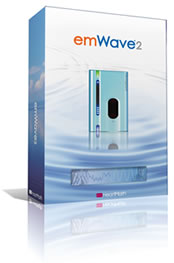
Using colorful LED displays, audio feedback, the emWave breathing pacer and an instructional stress-relief technique on how to generate positive emotions will improve your coherence level — sharpening your ability to reduce stress and increase vitality, mental clarity and emotional balance.

Researchers from top medical institutions such as Duke Medical Center, Stanford, Kaiser Permanente, University of North Carolina, Blue Cross Blue Shield and Sutter Health are currently looking at how increasing emotional fitness with the emWave and the HeartMath System can be used to help with the stress associated sleep disturbance, migraine headaches, chronic pain, social and performance anxiety, ADHD, depression, chronic fatigue, weight loss and academic performance.
Professional Development for Educators
The Resilient Educator® Program
As educators develop their own emotional empowerment and resilience in the face of complex issues and challenges, they cut through stressors, save lots of energy and cut down on wasted time. They have more tolerance and less reactivity with each other and with students, setting up a healthier learning climate in the school and classroom.

The Resilient Educator has received high marks from teachers and administrators across the country. Research has shown that educators attending Resilient Educator trainings gained significant improvement in motivation and positive outlook and had major reductions in stress, fatigue, exhaustion and anger. The desire to quit the job also was greatly reduced. For example, prior to receiving Resilient Educator training, 34% of school administrators and K-12 teachers in a Kentucky school district said they felt exhausted in the job. Three months after receiving training, that number had dropped to 11%. Those who said they felt like quitting their job dropped from 21% to 14% over the same three-month period.
Similar before-and-after assessments are available for every participant in your school. The two-, four- or six-hour in-service training teaches scientifically-validated tools and strategies proven to stop the negative impacts of stress – mentally, emotionally and physically.
Inside Story: Understanding the Power of Feelings
The Inside Story (Grades 7-12+)
In today’s world, students must deal with increasing levels of emotional stress in their relationships with peers, teachers and family. A lot of stress occurs outside the classroom and is brought into class each day. This stress operates as a preoccupying emotional undercurrent that distracts and disengages students from focusing and learning.
The Inside Story is full of vital information about the healthy behavior and the physiological and psychological well-being of high school and college students. Drawing on the latest research in neuroscience and emotional physiology, this engaging book helps students understand the interplay between their bodies, emotions, attitudes and performance. By learning to understand and self-manage emotions, improve attitudes and relationships, they experience greater success in all areas of their lives.
"This is so relevant to the needs of my students! It is an excellent guide that helps them understand the connection between their emotions, their daily lives and their health and performance."
— Pam Poholsky, Health Education, Murrysville, Pa.
The Inside Story will…
- Teach a research-proven emotional stress management tool
- Improve attitudes and behaviors
- Increase focus and achievement
- Help students perform at their best
Books, e-Books, MP3 downloads, and Scientific Monographs
For almost 20 years Doc Childre and the HeartMath® staff have been producing books, training programs, research papers, articles, technology and learning systems which combined make up the HeartMath System. Go to: HeartMath Stress Relief books
Last Updated: 2022-03-01 ( Remote )
Copyright © 2022 HeartMath, Inc. All rights reserved.
HeartMath is a registered trademark of Quantum Intech, Inc. For all HeartMath trademarks go to: www.heartmath.com/trademarks